2017英语四级传统文化翻译模拟题:茶文化
英语四级翻译模拟题13
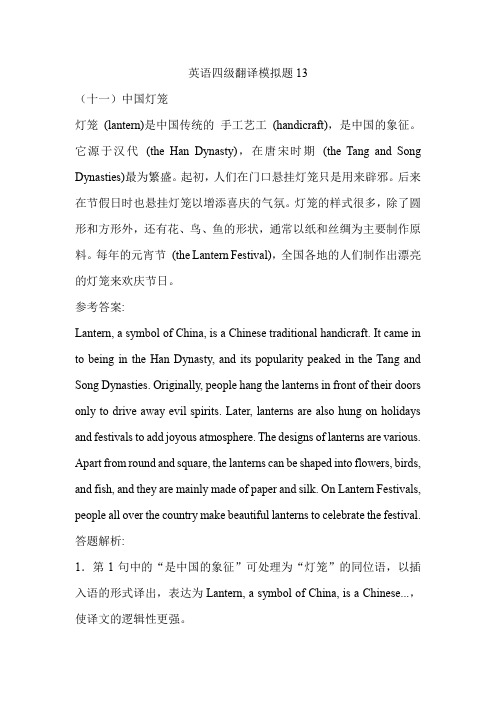
英语四级翻译模拟题13(十一)中国灯笼灯笼(lantern)是中国传统的手工艺工(handicraft),是中国的象征。
它源于汉代(the Han Dynasty),在唐宋时期(the Tang and Song Dynasties)最为繁盛。
起初,人们在门口悬挂灯笼只是用来辟邪。
后来在节假日时也悬挂灯笼以增添喜庆的气氛。
灯笼的样式很多,除了圆形和方形外,还有花、鸟、鱼的形状,通常以纸和丝绸为主要制作原料。
每年的元宵节(the Lantern Festival),全国各地的人们制作出漂亮的灯笼来欢庆节日。
参考答案:Lantern, a symbol of China, is a Chinese traditional handicraft. It came in to being in the Han Dynasty, and its popularity peaked in the Tang and Song Dynasties. Originally, people hang the lanterns in front of their doors only to drive away evil spirits. Later, lanterns are also hung on holidays and festivals to add joyous atmosphere. The designs of lanterns are various. Apart from round and square, the lanterns can be shaped into flowers, birds, and fish, and they are mainly made of paper and silk. On Lantern Festivals, people all over the country make beautiful lanterns to celebrate the festival.答题解析:1.第1句中的“是中国的象征”可处理为“灯笼”的同位语,以插入语的形式译出,表达为Lantern, a symbol of China, is a Chinese...,使译文的逻辑性更强。
英语四六级考试模拟翻译题-喝茶 刺绣(含参考答案)

无论中国人走到哪里,都不会改掉喝茶的习惯。
茶最先由中国人发现,它是中国人生活中不可或缺的组成部分。
有一句中国谚语将基本的日常必需品称为柴米油烟酱醋茶。
一千多年以来,饮茶的习俗已经在中国人心中根深蒂固。
唐朝时,一个名叫陆羽的人写了世界上第一部关于茶的著作——《茶经》,这部书有助于在中国推广饮茶艺术。
Wherever the Chinese go, the custom of drinking tea follows. Tea was first discovered by the Chinese and it is an indispensable part of the life of the Chinese. A Chinese saying identifies the basic daily necessities as fuel, rice, oil, salt, soy sauce,vinegar and tea. The custom of drinking tea has been ingrained in the Chinese for over a thousand years. In Tang Dynasty, a man named Lu Yu created the first compendium in the world on tea, Book of Tea. This work helped to popularize the art of tea drinking all across China.刺绣是一种具有悠久传统的民间艺术,在中国艺术和手工艺品史上占有重要地位。
刺绣的长期发展离不开蚕的饲养和纺丝技术的发展。
中国是世界上第一个发现和使用丝绸的国家。
早在5000年前,中国就已经开始饲养蚕。
丝绒和丝制品的生产促进了刺绣艺术的诞生。
时至今日,丝绣几乎已经传遍整个中国。
中国茶文化英语作文带翻译

中国茶文化英语作文带翻译in China , tea has a very long history and has formed the Chinese tea culture. At the same time, tea is beneficial to our health, thus it is well received by many people. Chinese tea culture is both extensive and profound, which not only contains the level of material culture, but also includes a deep level of spiritual civilization. Referring to Chinese tea, we can trace it back to ancient times, which flourished in the Tang and Song Dynasties, Since then, the spirit of tea has penetrated into the court and society, going deep into Chinese poetry, painting, calligraphy , religion and medicine. For thousands of years, China has accumulated a great deal of culture in tea cultivation and production, moreover, enriching the spiritual culture of tea.在中国,茶具有非常悠久的历史,并且已经形成了中国茶文化。
与此同时,茶有益于我们的健康,因此受到许多人的喜爱。
茶文化英语带翻译

For foreigners who want to work in tea houses, it is also crucial to learn some common phrases and basic communication skills used in tea houses. This article will introduce some commonly used English expressions in tea houses, as well as some practical communication skills, to help readers better understand and apply English in tea houses.
由于茶楼的特殊环境和特色,茶楼英语的学习和应用有其独特之处。通过不断学习和积累经验,茶楼从业人员可以更好地掌握茶楼英语,为促进茶文化的传播和发展做出更大的贡献。
以上就是关于茶楼英语的一些介绍和应用技巧,希望可以帮助到有需要的读者。茶楼作为传统的休闲场所,在融合传统文化和国际交流的过程中,茶楼英语的学习和应用将变得越来越重要。
5. How many people are in your party? 你们几位?
6. Please enjoy your tea. 请慢慢品尝您的茶。
7. Is there anything else I can help you with? 还有什么我可以帮助您的吗?
以上是一些茶楼常用的英语表达,服务员可以通过这些句子与外国客人进行基本的交流。此外,服务员还可以学习一些关于茶的基本知识和制作过程的英语表达,以便能够更好地向客人介绍茶的种类和特点。
英语四级考试翻译题传统文化各种
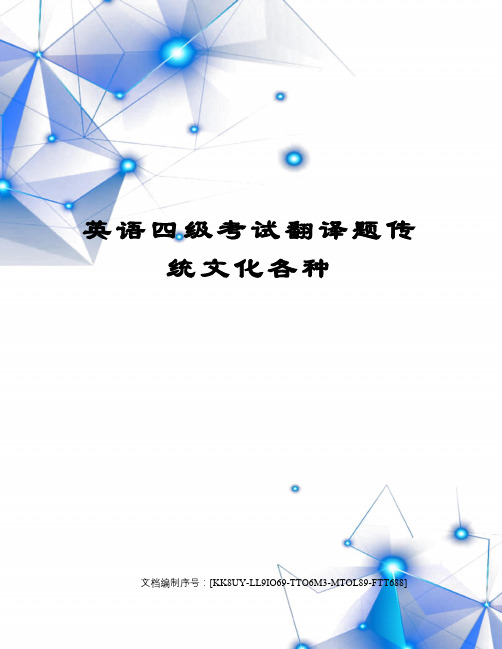
英语四级考试翻译题传统文化各种文档编制序号:[KK8UY-LL9IO69-TTO6M3-MTOL89-FTT688]一、中国龙对龙图腾他的崇拜在中国大约已绵延了八千多年。
中国龙是古人将鱼、蛇、马、牛等动物与云雾、雷电等自然天象集合而成的一种神物。
中国龙的形成与中华民族的多元融合过程同步。
在中国人的心目中,龙具有振奋腾飞、开拓变化的寓意和团结凝聚的精神。
译文Chinese Dragon Dragon totem worship in China has been around for the last 8,000 years. The ancients in China considered the dragon (or loong) a fetish that combines animals including the fish, snake, horse and ox with cloud, thunder, lightning and other natural celestial phenomena. The Chinese dragon was formed in accordance with the multicultural fusion process of the Chinese nation. To the Chinese, the dragon signifies innovation and cohesion.二、秧歌多彩的表演服装,他们的表演动作有力迅速。
在农历春节、元宵节等节日期间,人们一旦听到锣鼓声,不管外面天气有多冷,他们都会蜂拥到街上看秧歌舞表演。
近年来,中国东北某些城市的老年人自发组织了了秧歌队,队员常年通过跳秧歌舞来保持健康,同事他们也乐在其中。
Yangko is one of tradition folk dance of Han in is usually performed in northern provinces. The dancers usually wear colorful and light costumes, and the performance is powerful and rapid. During some festivals such as Spring Festival, Lantein Festival, if people hear the sound of drum and gong, no matter how cold the weather is , they will come to street and appreciate the Yangko. Recent years, the old people in city of east-northern of China organized the team of Yangko by themselves, the teamers keep their health by dancing Yangko the whole year.三、长城长城是人类创造的世界奇迹之一。
英语介绍茶文化

英语介绍茶文化English:Tea culture is a rich and intricate part of Chinese history, dating back thousands of years. It encompasses not just the act of drinking tea, but also the cultivation, processing, and appreciation of tea leaves. With its origins in ancient China, tea has evolved into a symbol of hospitality, respect, and harmony. The tea ceremony, known as "茶道" (chá dào) or "茶艺" (chá yì), is a ceremonial way of preparing and serving tea, embodying principles of Zen Buddhism such as harmony, respect, purity, and tranquility. Different regions in China have their own unique tea cultures, with famous varieties like green tea, black tea, oolong tea, and Pu'er tea. Each type of tea has its own distinct flavor profile, health benefits, and cultural significance. Beyond China, tea culture has spread across the globe, influencing various rituals, customs, and lifestyles. It has become an integral part of social interactions, whether it's the English tradition of afternoon tea or the Japanese tea ceremony. Overall, tea culture is not just about the beverage itself but also about the values, traditions, and rituals associated with it, making it a fascinating and essential aspect of Chinese heritage.中文翻译:茶文化是中国历史上丰富而复杂的一部分,可以追溯到几千年前。
英文作文茶文化附中文翻译
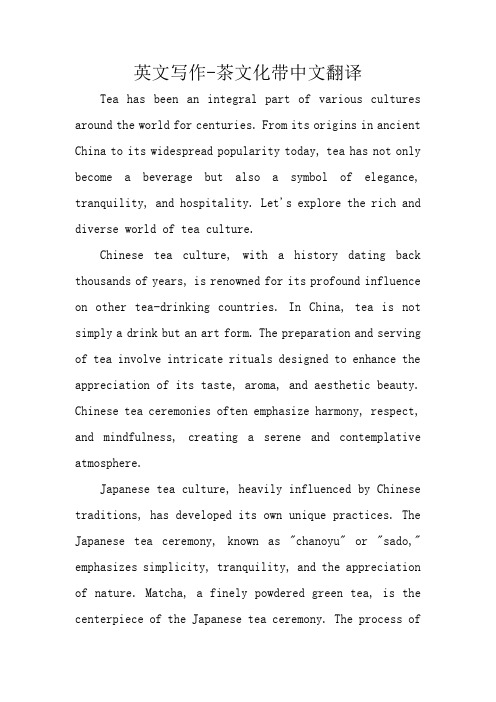
英文写作-茶文化带中文翻译Tea has been an integral part of various cultures around the world for centuries. From its origins in ancient China to its widespread popularity today, tea has not only become a beverage but also a symbol of elegance, tranquility, and hospitality. Let's explore the rich and diverse world of tea culture.Chinese tea culture, with a history dating back thousands of years, is renowned for its profound influence on other tea-drinking countries. In China, tea is not simply a drink but an art form. The preparation and serving of tea involve intricate rituals designed to enhance the appreciation of its taste, aroma, and aesthetic beauty. Chinese tea ceremonies often emphasize harmony, respect, and mindfulness, creating a serene and contemplative atmosphere.Japanese tea culture, heavily influenced by Chinese traditions, has developed its own unique practices. The Japanese tea ceremony, known as "chanoyu" or "sado," emphasizes simplicity, tranquility, and the appreciation of nature. Matcha, a finely powdered green tea, is the centerpiece of the Japanese tea ceremony. The process ofpreparing and serving matcha involves precise movements and gestures, showcasing the beauty of minimalism and attention to detail.In India, tea holds a significant cultural and social importance. Masala chai, a spiced tea blend, is a popular choice in Indian households. Tea is not only enjoyed as a refreshing beverage but also serves as a catalyst for social gatherings and discussions. The concept of "chai pe charcha," meaning "tea and conversation," reflects the role of tea as a facilitator of connections and conversations among people.Tea culture is not limited to East Asia and India. In the United Kingdom, the tradition of afternoon tea holds a special place. It is a cherished ritual that typically involves tea served with scones, finger sandwiches, and pastries. The British take pride in their tea etiquette, with proper teapot pouring techniques and the use of fine china.No matter where tea culture is embraced, it promotes a sense of relaxation, mindfulness, and social interaction. Whether it is a formal ceremony or a casual gathering with friends, tea offers a moment of pause in our busy lives,allowing us to appreciate the simple pleasures and connect with others.中文翻译为:茶在世界各地的文化中已经有数百年的历史,它不仅成为一种饮料,更是优雅、宁静和热情待客的象征。
茶文化英语作文带翻译3篇

茶文化英语作文带翻译茶文化英语作文带翻译3篇在生活、工作和学习中,大家都有写作文的经历,对作文很是熟悉吧,借助作文人们可以反映客观事物、表达思想感情、传递知识信息。
一篇什么样的作文才能称之为优秀作文呢?下面是小编为大家收集的茶文化英语作文带翻译,希望能够帮助到大家。
茶文化英语作文带翻译篇1Since I started my major in the tea culture of ChinaI have been deeply impressed by its sophistication and beauty.I would like to share some fascinating aspects of the tea culture of China.In a country with the history of five thousand yearsthe Chinese tea drinking habit dated back to the Tang Dynasty (618-907AD).It became a national tradition and led to development of a delicate tea drinking ritual.Over the centuriespoets and artists in China wrote many marvelous masterpiecesin appreciation of tea and Chinese people’s constant love of tea drinking .One of the best-known writers is Lu Yuwho was regarded as the “Tea Sage ” for he composed the first book on tea.In his classic bookhe detailed his studies of teasuch as the origin of teatea toolstea pickingtea cookingtea ceremony and well-known areas where tea was grown.And the valuable knowledge he recorded has laid foundation for modern tea culture development.based on ways in which tea leaves are processedthere are five distinct types of tea.They are as follow:the green teathe black teathe Wulong teathe compressed tea and the scented tea.Among themmay foreigners are familiar with the green tea.The Longjing teaof the green typehas a reputation.自从我开始在中国的茶文化专业,我已深深感受到它的精致和美丽。
茶文化英语翻译
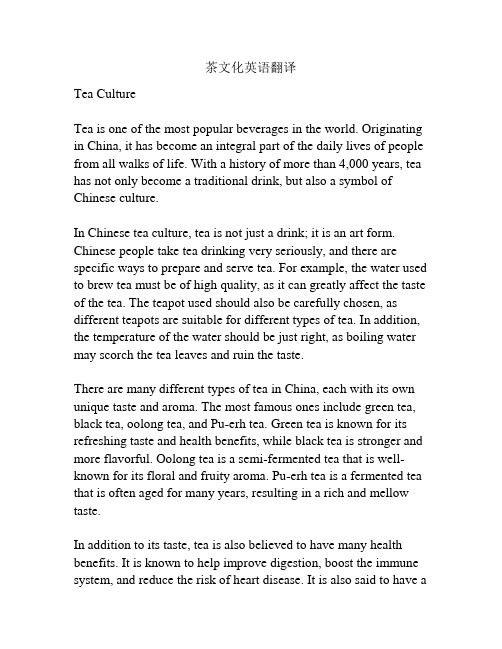
茶文化英语翻译Tea CultureTea is one of the most popular beverages in the world. Originating in China, it has become an integral part of the daily lives of people from all walks of life. With a history of more than 4,000 years, tea has not only become a traditional drink, but also a symbol of Chinese culture.In Chinese tea culture, tea is not just a drink; it is an art form. Chinese people take tea drinking very seriously, and there are specific ways to prepare and serve tea. For example, the water used to brew tea must be of high quality, as it can greatly affect the taste of the tea. The teapot used should also be carefully chosen, as different teapots are suitable for different types of tea. In addition, the temperature of the water should be just right, as boiling water may scorch the tea leaves and ruin the taste.There are many different types of tea in China, each with its own unique taste and aroma. The most famous ones include green tea, black tea, oolong tea, and Pu-erh tea. Green tea is known for its refreshing taste and health benefits, while black tea is stronger and more flavorful. Oolong tea is a semi-fermented tea that is well-known for its floral and fruity aroma. Pu-erh tea is a fermented tea that is often aged for many years, resulting in a rich and mellow taste.In addition to its taste, tea is also believed to have many health benefits. It is known to help improve digestion, boost the immune system, and reduce the risk of heart disease. It is also said to have acalming effect and can help alleviate stress. That is why many people choose to have a cup of tea after a long day to relax and unwind.Tea is not only popular in China, but also in many other countries around the world. In Japan, the tea ceremony, known as "chanoyu", is a highly valued traditional art form. In England, afternoon tea is a popular social activity where people gather to enjoy tea, sandwiches, and cakes. In India, tea is commonly consumed in the form of chai, which is made with a blend of tea, milk, and spices. In conclusion, tea culture is an important part of Chinese tradition and has influenced many other cultures around the world. It is not just a simple beverage, but a symbol of hospitality, friendship, and relaxation. Whether it is sipping a cup of green tea in a traditional teahouse or enjoying a cup of English breakfast tea with scones and clotted cream, tea brings people together and provides a moment of tranquility in our busy lives.。
茶文化英语带翻译
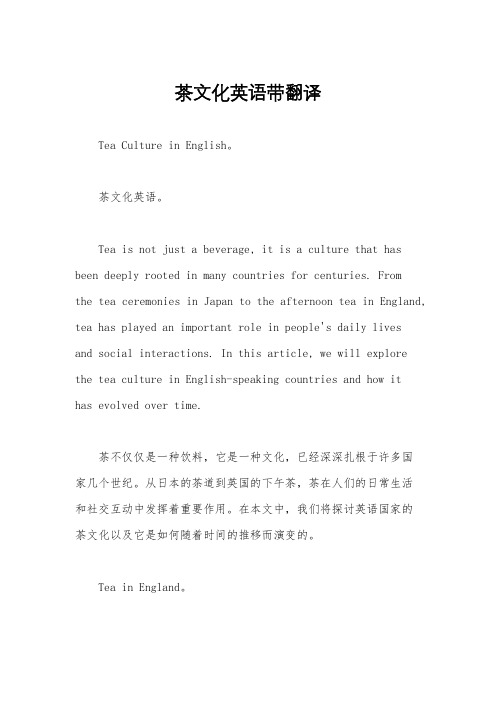
茶文化英语带翻译Tea Culture in English。
茶文化英语。
Tea is not just a beverage, it is a culture that has been deeply rooted in many countries for centuries. Fromthe tea ceremonies in Japan to the afternoon tea in England, tea has played an important role in people's daily livesand social interactions. In this article, we will explore the tea culture in English-speaking countries and how ithas evolved over time.茶不仅仅是一种饮料,它是一种文化,已经深深扎根于许多国家几个世纪。
从日本的茶道到英国的下午茶,茶在人们的日常生活和社交互动中发挥着重要作用。
在本文中,我们将探讨英语国家的茶文化以及它是如何随着时间的推移而演变的。
Tea in England。
英国的茶文化。
Tea has been a popular beverage in England since the17th century, when it was introduced by Catherine of Braganza, the queen consort of King Charles II. However, it was not until the 19th century that tea became a staple of British culture, thanks to the development of tea plantations in India and the reduction of its price. This led to the creation of the tradition of afternoon tea, which is still popular today.自17世纪以来,茶在英国一直是一种受欢迎的饮料,当时由查尔斯二世国王的皇后卡瑟琳·布拉干萨引入。
中国传统文化之茶文化相关语法和写作练习
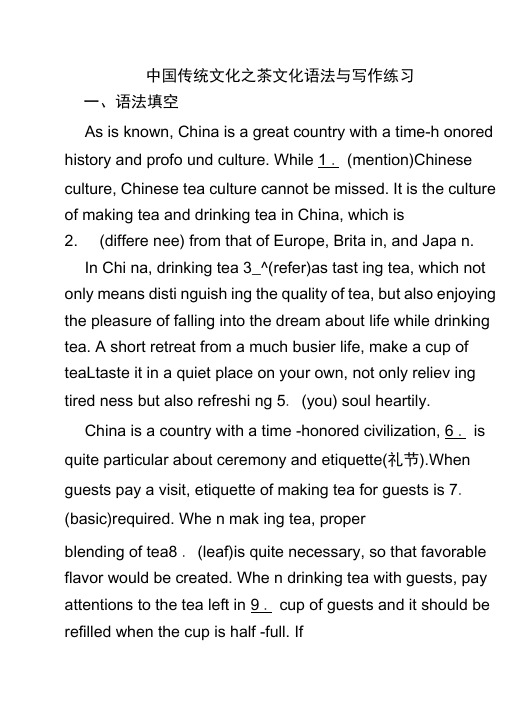
中国传统文化之茶文化语法与写作练习一、语法填空As is known, China is a great country with a time-h onored history and profo und culture. While 1 . (mention)Chinese culture, Chinese tea culture cannot be missed. It is the culture of making tea and drinking tea in China, which is2. (differe nee) from that of Europe, Brita in, and Japa n.In Chi na, drinking tea 3_^(refer)as tast ing tea, which not only means disti nguish ing the quality of tea, but also enjoying the pleasure of falling into the dream about life while drinking tea. A short retreat from a much busier life, make a cup of teaLtaste it in a quiet place on your own, not only reliev ing tired ness but also refreshi ng 5. (you) soul heartily.China is a country with a time -honored civilization, 6 . is quite particular about ceremony and etiquette(礼节).When guests pay a visit, etiquette of making tea for guests is 7. (basic)required. Whe n mak ing tea, properblending of tea8 . (leaf)is quite necessary, so that favorable flavor would be created. Whe n drinking tea with guests, pay attentions to the tea left in 9 . cup of guests and it should be refilled when the cup is half -full. If10. (accompa ny )with tea dessert, can dies and dishes, drinking tea would be more tasteful and joyful.参考答案1. mentioning2 . different3 . is referred4 . and5. your6 . which7 . basically8. leaves9. the 10. accompaniedA teahouse is a special house which primarily serves tea and other light refreshme nts. Its fun cti on varies widely 11 . (depe nd) on the culture. In China, a teahouse is a place 12. people gather to enjoy tea, chat and socialize. It 13 . (consider) as a symbol of Chinese tea culture and people ' s leisure lives.Chin ese teahouses enjoy a Ion g-sta ndi nghistory. They developed from tea sta nds in thes livi ng Western Jin Dynasty, 14 ・ (take) shape in the Tang Dyn asty, developed 15. (gradual) in the Song, Yuan ,Mi ng and Qing dyn asties and became boom ing in moder n times. In the Song Dyn asty, teahouse existed all overcities and villages, 16 . a rate comparable with that of restaura nts. The owners preferred to decorated their teahouses with pait ings of celebrities and rare and preciousplants 147. (attract) customers .In the Mi ng and Qing dyn asties, the n umber of teahouses went bey ond that of restaurants, gaining more 18 . (popular) and becom ing more famous. Later, the acculturati on of Wester n culture forces traditi onal Chin eseteahouses to take on19.new look. After reform and opening -up, with the rapid developme nt of the economy and 20. (evide nee) improveme nt of people ' sta ndards, teahouses flowered in Chi na.参考答案11.depe nding 12. where 13.is con sidered 14. took 15. gradually 16. at17.to attract 18.popularity19. A 20.evident二、短文改错Dear Tom,How time flies! Next week is my birthday. Happy birthday to you! I've sent for you a can of tea as a gift, hoping that you will like it. Having known that you have a great interest Chinese culture, now I will introduce Chinese tea culture to you.Enjoy a long history of more than 4,000 years, Chinese tea never fail to attract many people in China. Generally speaking, there're more kinds of tea in China, included green tea, red tea and so on. Most Chinese are fond of drinking tea, that is served not only at tea house and restaurants but also at home. It has been discovered that drinking tea does a lot of good to people's health ,making you relaxing and refreshed. Moreover, it's said that green tea can prevent cancers. I'm sure that tea is becoming increasing popular with people around the world.I hope you will love Chinese tea and tea culture. Happy birthday and every day!Yours, LiHua【答案】1. m尸your2.将for 去掉3. 在interest 后面加in4. Enjoy f Enjoying5. fail f fails6. more f many7. included f including8. that f which9. relaxing f relaxed10. increasing f increasingly三、书面表达假定你是李华。
茶文化英语句子与翻译
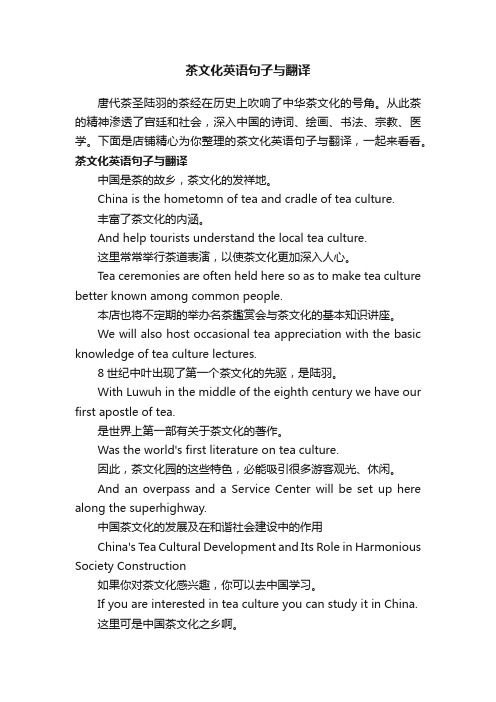
茶文化英语句子与翻译唐代茶圣陆羽的茶经在历史上吹响了中华茶文化的号角。
从此茶的精神渗透了宫廷和社会,深入中国的诗词、绘画、书法、宗教、医学。
下面是店铺精心为你整理的茶文化英语句子与翻译,一起来看看。
茶文化英语句子与翻译中国是茶的故乡,茶文化的发祥地。
China is the hometomn of tea and cradle of tea culture.丰富了茶文化的内涵。
And help tourists understand the local tea culture.这里常常举行茶道表演,以使茶文化更加深入人心。
Tea ceremonies are often held here so as to make tea culture better known among common people.本店也将不定期的举办名茶鑑赏会与茶文化的基本知识讲座。
We will also host occasional tea appreciation with the basic knowledge of tea culture lectures.8世纪中叶出现了第一个茶文化的先驱,是陆羽。
With Luwuh in the middle of the eighth century we have our first apostle of tea.是世界上第一部有关于茶文化的著作。
Was the world's first literature on tea culture.因此,茶文化园的这些特色,必能吸引很多游客观光、休闲。
And an overpass and a Service Center will be set up here along the superhighway.中国茶文化的发展及在和谐社会建设中的作用China's Tea Cultural Development and Its Role in Harmonious Society Construction如果你对茶文化感兴趣,你可以去中国学习。
英语四级翻译10篇
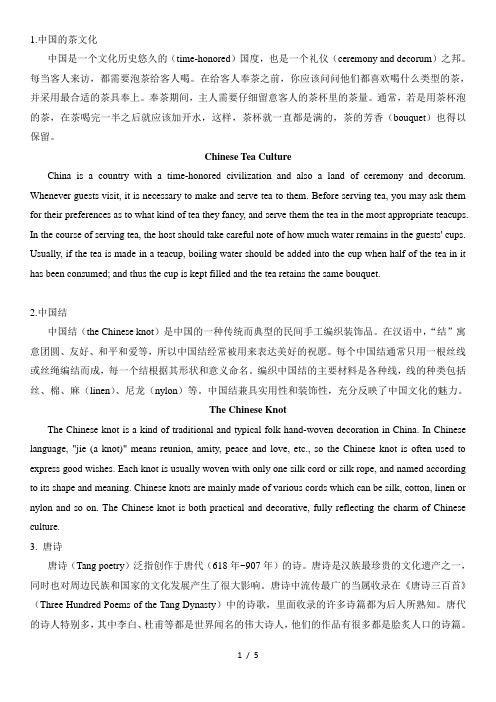
1.中国的茶文化中国是一个文化历史悠久的(time-honored)国度,也是一个礼仪(ceremony and decorum)之邦。
每当客人来访,都需要泡茶给客人喝。
在给客人奉茶之前,你应该问问他们都喜欢喝什么类型的茶,并采用最合适的茶具奉上。
奉茶期间,主人需要仔细留意客人的茶杯里的茶量。
通常,若是用茶杯泡的茶,在茶喝完一半之后就应该加开水,这样,茶杯就一直都是满的,茶的芳香(bouquet)也得以保留。
Chinese Tea CultureChina is a country with a time-honored civilization and also a land of ceremony and decorum. Whenever guests visit, it is necessary to make and serve tea to them. Before serving tea, you may ask them for their preferences as to what kind of tea they fancy, and serve them the tea in the most appropriate teacups. In the course of serving tea, the host should take careful note of how much water remains in the guests' cups. Usually, if the tea is made in a teacup, boiling water should be added into the cup when half of the tea in it has been consumed; and thus the cup is kept filled and the tea retains the same bouquet.2.中国结中国结(the Chinese knot)是中国的一种传统而典型的民间手工编织装饰品。
茶艺与茶文化英文翻译作文
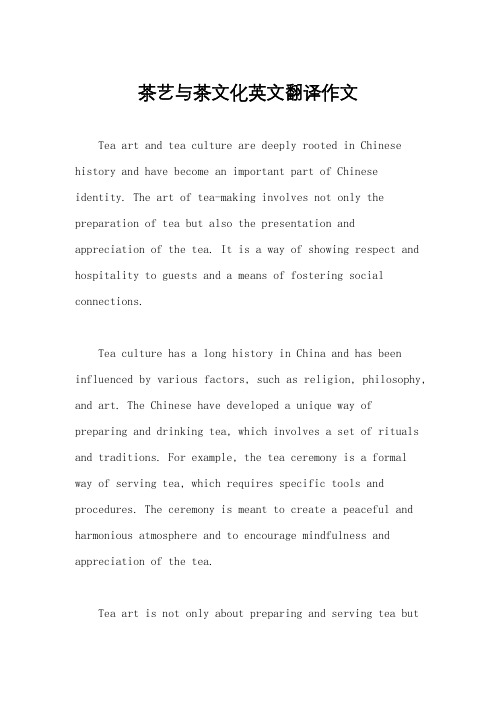
茶艺与茶文化英文翻译作文Tea art and tea culture are deeply rooted in Chinese history and have become an important part of Chinese identity. The art of tea-making involves not only the preparation of tea but also the presentation andappreciation of the tea. It is a way of showing respect and hospitality to guests and a means of fostering social connections.Tea culture has a long history in China and has been influenced by various factors, such as religion, philosophy, and art. The Chinese have developed a unique way of preparing and drinking tea, which involves a set of rituals and traditions. For example, the tea ceremony is a formal way of serving tea, which requires specific tools and procedures. The ceremony is meant to create a peaceful and harmonious atmosphere and to encourage mindfulness and appreciation of the tea.Tea art is not only about preparing and serving tea butalso about the aesthetics of the tea set and the environment in which the tea is enjoyed. The tea set, which includes the tea pot, cups, and other utensils, is often made of delicate porcelain or clay and is decorated with intricate patterns and designs. The tea room is also an important aspect of tea art, and it is designed to create a serene and relaxing atmosphere. The tea room may be decorated with calligraphy, paintings, or other art forms that reflect the beauty of nature.Tea art and tea culture have also had an impact on Chinese literature and poetry. Many famous poets andwriters have written about the beauty and significance of tea, and their works have become an important part of Chinese literature. For example, Lu Yu, a famous tea master from the Tang dynasty, wrote a book called "The Classic of Tea," which is still considered a masterpiece of Chinese literature.In conclusion, tea art and tea culture are an integral part of Chinese identity and have a long and rich history. They reflect the Chinese values of hospitality, respect,and harmony, and they have influenced many aspects of Chinese life, including literature, art, and philosophy. Today, tea art and tea culture continue to be celebrated and practiced in China and around the world.。
茶文化和茶道的英文翻译
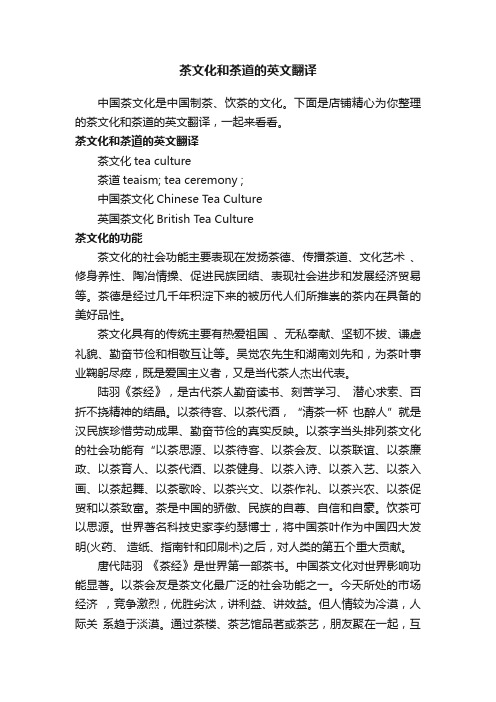
茶文化和茶道的英文翻译中国茶文化是中国制茶、饮茶的文化。
下面是店铺精心为你整理的茶文化和茶道的英文翻译,一起来看看。
茶文化和茶道的英文翻译茶文化tea culture茶道teaism; tea ceremony ;中国茶文化Chinese Tea Culture英国茶文化British Tea Culture茶文化的功能茶文化的社会功能主要表现在发扬茶德、传播茶道、文化艺术、修身养性、陶冶情操、促进民族团结、表现社会进步和发展经济贸易等。
茶德是经过几千年积淀下来的被历代人们所推崇的茶内在具备的美好品性。
茶文化具有的传统主要有热爱祖国、无私奉献、坚韧不拔、谦虚礼貌、勤奋节俭和相敬互让等。
吴觉农先生和湖南刘先和,为茶叶事业鞠躬尽瘁,既是爱国主义者,又是当代茶人杰出代表。
陆羽《茶经》,是古代茶人勤奋读书、刻苦学习、潜心求索、百折不挠精神的结晶。
以茶待客、以茶代酒,“清茶一杯也醉人”就是汉民族珍惜劳动成果、勤奋节俭的真实反映。
以茶字当头排列茶文化的社会功能有“以茶思源、以茶待客、以茶会友、以茶联谊、以茶廉政、以茶育人、以茶代酒、以茶健身、以茶入诗、以茶入艺、以茶入画、以茶起舞、以茶歌呤、以茶兴文、以茶作礼、以茶兴农、以茶促贸和以茶致富。
茶是中国的骄傲、民族的自尊、自信和自豪。
饮茶可以思源。
世界著名科技史家李约瑟博士,将中国茶叶作为中国四大发明(火药、造纸、指南针和印刷术)之后,对人类的第五个重大贡献。
唐代陆羽《茶经》是世界第一部茶书。
中国茶文化对世界影响功能显著。
以茶会友是茶文化最广泛的社会功能之一。
今天所处的市场经济,竞争激烈,优胜劣汰,讲利益、讲效益。
但人情较为冷漠,人际关系趋于淡漠。
通过茶楼、茶艺馆品茗或茶艺,朋友聚在一起,互通信息,交流感情,增进了解,沟通友谊。
朋友相聚在旧式茶馆里,随意说笑,回忆人生,重新享受到生命的乐趣。
古代就有“寒夜客来茶当酒”之说,以茶代酒体现传统美德,符合今天中央倡导的厉行节约制止奢侈浪费行为的规定要求。
茶文化英语练习题

茶文化英语练习题### Tea Culture English Practice Questions#### Section A: Vocabulary1. Match the following tea-related terms with their definitions.- Tea Ceremony: a traditional Japanese cultural activity - Tea Set: a collection of utensils used for making and drinking tea- Tea Leaf: the dried leaves of the tea plant used for making tea- Tea Master: a person skilled in the art of tea making and serving- Tea Tasting: the process of evaluating the quality of tea2. Choose the correct word to fill in the blanks.- The brewing of tea requires a precise amount of water and time.- The aroma of the tea filled the room, inviting everyone to sit and enjoy.- The flavors of the tea can vary depending on the type of leaf used.#### Section B: Reading ComprehensionRead the following passage and answer the questions:Passage:Tea, originating from China, has been a significant part of Eastern culture for centuries. It is not only a beverage but also a symbol of hospitality and a means of socialinteraction. The art of tea making, known as the tea ceremony, is a ritual performed in Japan, where the preparation and serving of matcha, a powdered green tea, is a meditative practice. Tea ceremonies are conducted with great respect and precision, reflecting the harmony, respect, purity, and tranquility of the tea culture.Questions:1. Where is tea believed to have originated?2. What does tea symbolize in Eastern culture?3. What is the tea ceremony in Japan called, and what is its significance?4. What is matcha, and how is it related to the tea ceremony?#### Section C: Grammar FocusFill in the blanks with the correct form of the verbs in parentheses.- The tea ceremony (be) a tradition in Japan for many centuries.- When you (visit) a tea house, it is polite to (wait) until the tea master (serve) you.- The tea master (prepare) the tea with great care, ensuring each step (be) performed correctly.- After the tea (serve), it is customary to (appreciate) the aroma before (drink) it.#### Section D: Writing TaskWrite a short essay (100-150 words) describing the importance of tea in Chinese culture. Mention its historical significance, social role, and any traditional practices associated with tea drinking.Sample Answer:Tea has been an integral part of Chinese culture forthousands of years. Historically, it was a tribute to the emperor and a symbol of wealth and status. Socially, tea is a means of hospitality, often shared among friends and family during gatherings. The traditional Chinese tea ceremony,known as "Gongfu Cha," is a meticulous process that emphasizes the quality of the tea and the skill of the server. It is a ritual that brings people together, promoting harmony and a sense of community.#### Section E: Cultural InsightsAnswer the following questions based on your understanding of tea culture.1. What are some common types of tea enjoyed around the world?2. How does the preparation method affect the taste of tea?3. Can you describe any traditional tea ceremonies from different cultures?This practice exercise is designed to enhance your understanding and appreciation of tea culture in an English context. It covers vocabulary, reading comprehension, grammar, writing, and cultural insights, providing a well-rounded approach to learning about this fascinating subject.。
英语四级翻译习题及参考译文:茶文化

英语四级翻译习题及参考译文:茶文化英语四级翻译习题及参考译文:茶文化以下是小编带来的英语四级翻译习题及参考译文:茶文化,欢迎阅读。
【翻译原文】茶文化是中国传统文化的重要组成部分,有着悠久的历史。
一代代的种植者和生产者使中国制茶工艺变得日臻完善。
茶和中国文化有着极其紧密的联系。
茶研究涉及的范围很广,有着丰富的'内容。
中国茶可以分为五类。
每一种都有不同于其他种类的味道和外观。
绿茶是办公室职员的最佳选择,它有助于防止电脑辐射(computer radiation),补充人体水分(moisture content)。
【参考译文】With a long history, tea culture is an important partof Chinese traditional culture. Generations ofgrowers and producers have perfected the Chineseway of manufacturing tea. Tea has an extremelyclose relationship with Chinese culture. The study oftea covers a wide field and has a very rich content. Chinese tea can be classified into fivecategories. Each kind is different from others in flavor and appearance. Green tea is the bestoption for office workers since it can help prevent computer radiation and supplementmoisture content of the human body.。
英语四六级考试模拟翻译题-喝茶

Translation中国人喜欢喝茶,也常常用茶来招待朋友和客人。
茶叶是中国人生活中的必需品。
茶叶原产于中国。
中国古人发现茶树后,起初是吧茶叶作为药用,后来才当作饮料。
花茶(scented tea)是中国独有的一种茶类,是在茶叶中加入香花熏制而成的。
最有名的花茶是福建产的茉莉花茶(jasmine tea)。
喝茶不但可以止渴,还能消除疲劳,帮助消化,预防一些疾病。
长期饮茶,对人的身体很有益处。
The Chinese people like to drink tea,and often entertain friends and guests with it. The tealeaf is a necessity in the life of the Chinese people. China is the homeland of tea. The ancient Chinese first used it for medicinal purposes before developing tea as a drink. Scented tea is peculiar to China,which is made by smoking tea leaves withfragrant flowers. The most famous one is jasmine tea produced in Fujian Province. Drinking tea can quench one’s thirst,dispel fatigue,help digestion and prevent some diseases. The constant drinking of tea is quite beneficial for people’s health.。
中国的传统文化茶,陶瓷,京剧作文英语
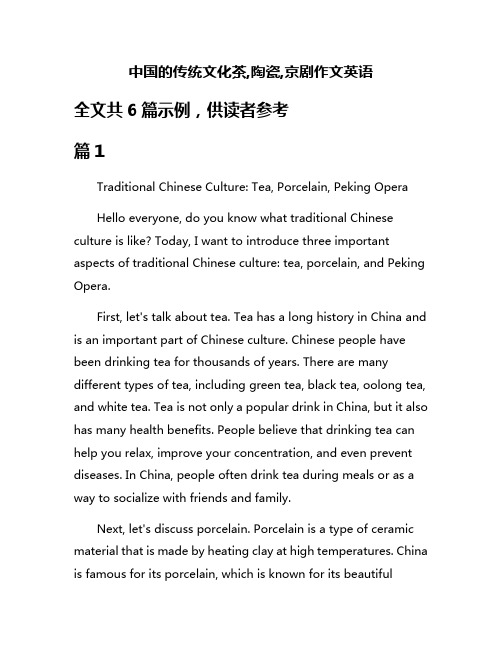
中国的传统文化茶,陶瓷,京剧作文英语全文共6篇示例,供读者参考篇1Traditional Chinese Culture: Tea, Porcelain, Peking OperaHello everyone, do you know what traditional Chinese culture is like? Today, I want to introduce three important aspects of traditional Chinese culture: tea, porcelain, and Peking Opera.First, let's talk about tea. Tea has a long history in China and is an important part of Chinese culture. Chinese people have been drinking tea for thousands of years. There are many different types of tea, including green tea, black tea, oolong tea, and white tea. Tea is not only a popular drink in China, but it also has many health benefits. People believe that drinking tea can help you relax, improve your concentration, and even prevent diseases. In China, people often drink tea during meals or as a way to socialize with friends and family.Next, let's discuss porcelain. Porcelain is a type of ceramic material that is made by heating clay at high temperatures. China is famous for its porcelain, which is known for its beautifuldesigns and high quality. Porcelain has been produced in China for over 1,000 years and is considered a symbol of Chinese craftsmanship. Chinese porcelain is often used for making teacups, plates, and vases. Many people around the world collect Chinese porcelain as a way to appreciate the beauty of Chinese culture.Finally, let's talk about Peking Opera. Peking Opera is a traditional form of Chinese theater that combines singing, dancing, and acrobatics. It is known for its colorful costumes, elaborate makeup, and dramatic storytelling. Peking Opera has been performed in China for over 200 years and has a rich history. The actors in Peking Opera are highly skilled and undergo years of training to master their craft. Peking Opera is a popular form of entertainment in China and is often performed during festivals and special occasions.In conclusion, tea, porcelain, and Peking Opera are all important parts of traditional Chinese culture. They represent the beauty, artistry, and history of China. By learning more about these aspects of Chinese culture, we can gain a better understanding and appreciation of this rich and diverse country. Thank you for listening!篇2Chinese traditional culture is super cool! Today let's chat about three traditional things: tea, ceramics, and Peking Opera.First off, let's talk about tea. Tea is a very important part of Chinese culture. Did you know that China is the birthplace of tea? There are so many different types of tea, like green tea, black tea, and oolong tea. People in China have been drinking tea for thousands of years! They even have tea ceremonies to show respect and appreciation for the tea. In China, tea isn't just a drink, it's a way of life!Next, let's chat about ceramics. Ceramics are a type of pottery made from clay and then fired in a kiln. Chinese ceramics are famous all over the world for their beautiful designs and craftsmanship. Did you know that the Chinese invented porcelain, which is a type of ceramic that is very strong and durable? People in China have been making ceramics for centuries, andit's still a popular art form today. Chinese ceramics can be found in museums and art galleries all over the world!Last but not least, let's talk about Peking Opera. Peking Opera is a traditional Chinese art form that combines music, singing, dancing, and acrobatics. The performers wear colorful costumes and elaborate makeup to tell stories from Chinese history and folklore. Peking Opera has been around for over 200years and is considered a cultural treasure in China. It's really fun to watch with all the cool costumes and movements!In conclusion, Chinese traditional culture is super awesome! From tea to ceramics to Peking Opera, there are so many cool things to learn about. I can't wait to continue exploring more about Chinese culture!篇3Traditional Chinese CultureHey guys, have you ever heard about traditional Chinese culture? Today, let's talk about three of them – tea, ceramics and Peking opera.First, let's talk about tea. Tea is a very important part of Chinese culture. People in China have been drinking tea for thousands of years. It is not only a beverage, but also a symbol of Chinese culture. There are many different types of tea in China, such as green tea, black tea, oolong tea and so on. People in China like to drink tea not only because of its delicious taste, but also because of its many health benefits. Drinking tea can help people relax, stay healthy and even lose weight. So, if you want to experience traditional Chinese culture, don't forget to try some Chinese tea.Next, let's talk about ceramics. Ceramics are another important part of Chinese culture. Chinese ceramics have a long history and are known all over the world for their beauty and elegance. Chinese ceramics are made of clay and then fired in a kiln to create beautiful and colorful works of art. Chinese ceramics come in many different shapes and sizes, such as bowls, plates, vases and so on. Some famous types of Chinese ceramics include blue and white porcelain, celadon and Jian ware. Chinese ceramics are not only beautiful to look at, but also very practical and durable. So, if you want to learn more about traditional Chinese culture, be sure to check out some Chinese ceramics.Finally, let's talk about Peking opera. Peking opera is a traditional form of Chinese theater that combines music, singing, dancing and acrobatics. It originated in Beijing in the late 18th century and has been passed down through the generations. Peking opera performances are known for their colorful costumes, elaborate makeup and unique singing style. Peking opera tells stories from Chinese history and folklore, such as famous battles, love stories and myths. Peking opera is not only a form of entertainment, but also a way to preserve Chinese culture and history. So, if you want to experience traditional Chinese culture in a fun and exciting way, be sure to watch a Peking opera performance.In conclusion, tea, ceramics and Peking opera are three important aspects of traditional Chinese culture. They have been passed down through the generations and continue to be enjoyed by people all over the world. So, if you want to learn more about traditional Chinese culture, don't forget to try some Chinese tea, check out some Chinese ceramics and watch a Peking opera performance. It will be a fun and educational experience.篇4Chinese Traditional Culture: Tea, Porcelain, Peking OperaHi everyone, today I want to talk about some cool things in Chinese traditional culture. First, let's talk about tea. Tea is a very important part of Chinese culture. People in China have been drinking tea for thousands of years. There are many different kinds of tea, like green tea, black tea, oolong tea, and more. Each kind of tea has its own special taste and benefits. People in China like to drink tea not only because it tastes good, but also because it is good for your health.Next, let's talk about porcelain. Porcelain is a kind of ceramic that is very famous in China. Chinese porcelain is known for its delicate design and beautiful colors. People in China have beenmaking porcelain for a very long time, and it is considered a symbol of Chinese culture. Porcelain is used to make all kinds of things, like plates, bowls, vases, and even statues.Lastly, let's talk about Peking Opera. Peking Opera is a traditional form of Chinese theater that combines singing, dancing, and acting. Peking Opera has been around for hundreds of years, and it is considered a national treasure in China. The actors in Peking Opera wear colorful costumes and elaborate makeup to tell stories from Chinese history and folklore. Many people in China love to watch Peking Opera because it is a beautiful and artistic form of entertainment.In conclusion, tea, porcelain, and Peking Opera are just a few examples of the rich and vibrant traditional culture of China. These things have been passed down from generation to generation, and they continue to be an important part of Chinese life today. I hope you enjoyed learning about these amazing aspects of Chinese culture!篇5Tea, Ceramics, and Peking Opera are three important aspects of traditional Chinese culture. Let me tell you more about each of them:First, let's talk about tea. Tea has been a part of Chinese culture for thousands of years. It is not just a beverage, but also a way of life. Chinese people believe that drinking tea can help to calm the mind, improve concentration, and promote good health. There are many different varieties of tea in China, such as green tea, black tea, oolong tea, and white tea. Each type of tea has its own unique flavor and benefits.Next, let's discuss ceramics. Ceramics are a type of pottery that is made from clay and fired at high temperatures. Chinese ceramics are known for their beautiful designs and craftsmanship. They are often decorated with intricate patterns and designs that reflect Chinese culture and traditions. Ceramics have been an important part of Chinese art and culture for centuries, and are highly prized for their beauty and quality.Finally, let's talk about Peking Opera. Peking Opera is a traditional form of Chinese theater that combines music, dance, acrobatics, and martial arts. It has a long history and is considered one of the highest forms of Chinese culture. Peking Opera performances often tell stories from Chinese history and mythology, and are known for their colorful costumes and elaborate makeup. Watching a Peking Opera performance is aunique and unforgettable experience that showcases the best of Chinese arts and culture.In conclusion, tea, ceramics, and Peking Opera are all important components of traditional Chinese culture. They each have their own unique history and significance, and play a vital role in preserving and celebrating China's rich cultural heritage. Learning about these aspects of Chinese culture can help us to better appreciate and understand the beauty and depth of this ancient and vibrant civilization.篇6Traditional Chinese culture is very interesting and full of rich history. In this article, I am going to talk about three aspects of traditional Chinese culture: tea, ceramics, and Peking opera.First of all, let's talk about tea. Tea has a long history in China and is an important part of Chinese culture. There are many different types of tea in China, such as green tea, black tea, and oolong tea. Chinese people believe that drinking tea is good for your health and can help to relax your mind. In China, tea is often served during important events, such as weddings or business meetings. The traditional Chinese tea ceremony is also abeautiful and intricate art form that has been passed down through generations.Next, let's talk about ceramics. Ceramics, or pottery, has been made in China for thousands of years. Chinese ceramics are known for their beautiful designs and high quality. The most famous type of Chinese ceramics is porcelain, which is a type of white ceramic that is very delicate and translucent. Chinese porcelain has been prized by people all over the world for its beauty and craftsmanship. Chinese ceramics are often decorated with intricate designs, such as dragons or flowers, and are still made using traditional techniques today.Finally, let's talk about Peking opera. Peking opera is a traditional form of Chinese theater that combines singing, acting, and acrobatics. Peking opera has a history of over 200 years and is considered one of the most important cultural treasures of China. Peking opera performances are very colorful and theatrical, with performers wearing elaborate costumes and makeup. The stories told in Peking opera are usually based on Chinese history or mythology and often involve themes of love, loyalty, and bravery.In conclusion, tea, ceramics, and Peking opera are all important aspects of traditional Chinese culture. They each havea long history and have been passed down through generations. By learning about these cultural traditions, we can gain a better understanding of China's rich and diverse heritage.。
- 1、下载文档前请自行甄别文档内容的完整性,平台不提供额外的编辑、内容补充、找答案等附加服务。
- 2、"仅部分预览"的文档,不可在线预览部分如存在完整性等问题,可反馈申请退款(可完整预览的文档不适用该条件!)。
- 3、如文档侵犯您的权益,请联系客服反馈,我们会尽快为您处理(人工客服工作时间:9:00-18:30)。
2017英语四级传统文化翻译模拟题:茶文化
•
中国茶文化
原文:中国是一个文化历史悠久的(time-honored)国度,也是一个礼仪(ceremony anddecorum)之邦。
每当客人来访,都需要泡茶给客人喝。
在给客人奉茶之前,你应该问问他们都喜欢喝什么类型的茶,并采用最合适的茶具奉上。
奉茶期间,主人需要仔细留意客人的茶杯里的茶量。
通常,若是用茶杯泡的茶,在茶喝完一半之后就应该加开水,这样,茶杯就一直都是满的,茶的芳香 (bouquet)也得以保留。
参考译文:Chinese Tea Culture
China is a country with a time-honored civilization and also a land of ceremony and decorum.Whenever guests visit, it is necessary to make and serve tea to them.Before serving tea, you may ask them
for their preferences as to what kind of tea they fancy, and serve them the tea in the most appropriate teacups.In the course of serving tea, the host should take careful note of how much water remains in the guests’ually, if the tea is made in a teacup,boiling water should be added into the cup when half of the tea in it has been consumed; and thus the cup is kept filled and the tea retains the same bouquet.。
